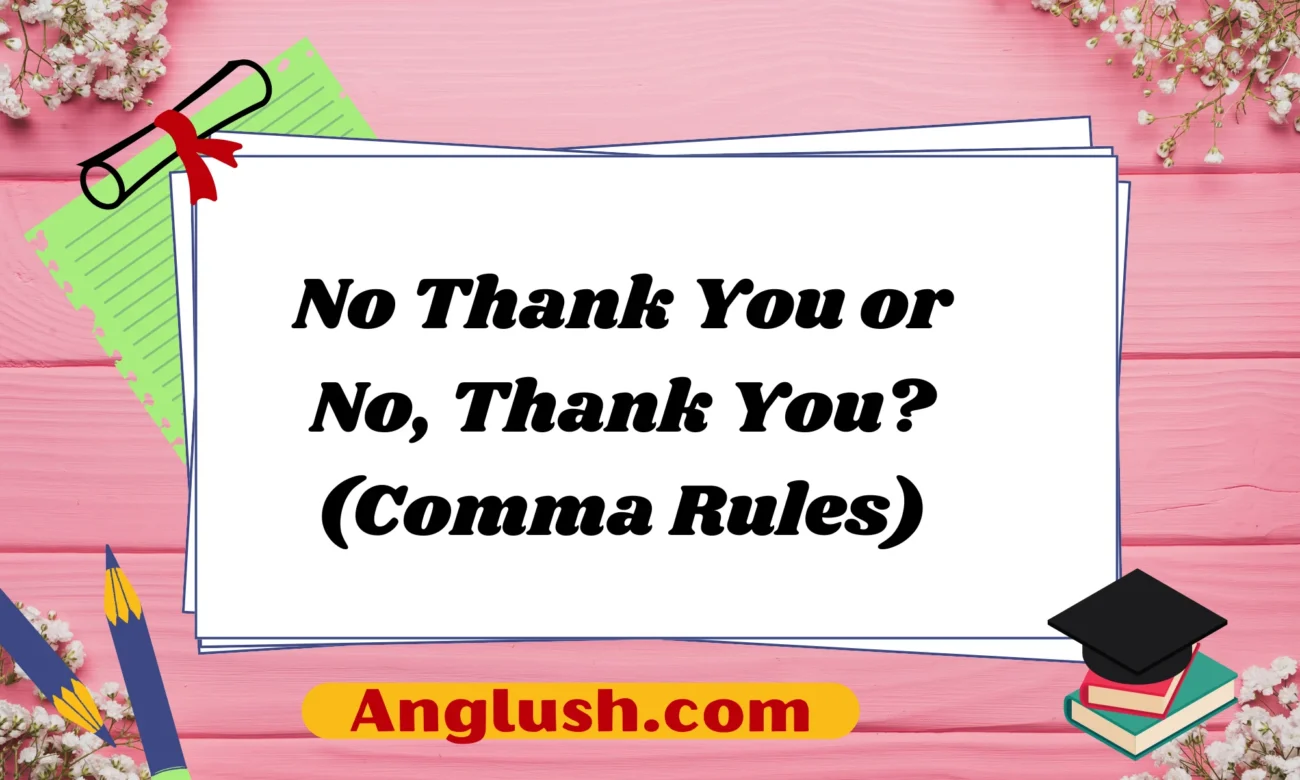Introduction
The phrase “No thank you” and “No, thank you” may seem nearly identical, but the comma makes a significant difference in tone and correctness. Understanding when to use a comma in polite expressions can enhance clarity and professionalism in both writing and speech.
In this article, we will explore:
- The correct use of “No, thank you” and why the comma matters
- Alternatives for various contexts (formal, casual, and professional)
- How tone affects polite refusals
- Texting-friendly examples for everyday use
By the end, you’ll have a better grasp of how to politely decline an offer while maintaining professionalism, warmth, or friendliness, depending on the situation.
No Thank You vs. No, Thank You: The Comma Rule
The difference between “No thank you” and “No, thank you” comes down to grammar and proper punctuation.
When to Use “No, Thank You” (With a Comma)
The correct way to write this phrase is:
✅ “No, thank you.”
The comma is essential because “thank you” is a form of direct address, meaning it addresses the person you are speaking to. The comma creates a natural pause, which makes the sentence clearer and more polite.
Examples:
- Waiter: Would you like more coffee?
- Correct: No, thank you.
- Incorrect: No thank you.
- Friend: Do you want to join us for dinner?
- Correct: No, thank you, but I appreciate the invite!
When Is “No Thank You” Acceptable?
Without a comma, “No thank you” is grammatically incorrect in most cases. However, it is sometimes used informally in text messages or casual speech.
Some people might argue that “no thank you” could be used as a noun phrase, meaning “I refuse with thanks,” but this usage is rare and not widely accepted in formal writing.
Example:
🚫 I responded with a polite no thank you. (This is uncommon and should be avoided in formal writing.)
To be grammatically correct and polite, always use “No, thank you.”
Alternatives to “No, Thank You” Based on Tone and Context
While “No, thank you” is polite, it may not always be the best choice. Here are different ways to decline something, categorized by formality and tone.
Formal Alternatives (Professional & Business Settings)
When declining offers in a professional environment, maintaining politeness and professionalism is key.
- I appreciate it, but I’ll have to decline.
- Thank you for the offer, but I must pass.
- No, but I sincerely appreciate the gesture.
- I’m grateful for the opportunity, but I’ll have to decline.
- Thank you, but I have to say no at this time.
✅ Example:
- Colleague: Would you like to join the meeting?
- Response: Thank you for the offer, but I must pass.
Casual Alternatives (Friends & Everyday Conversations)
In informal settings, you can be more relaxed while still sounding polite.
- Nah, I’m good. Thanks!
- I’ll pass, but thanks anyway!
- Nope, but I appreciate it!
- I think I’ll sit this one out, thanks!
- Not this time, but thanks!
✅ Example:
- Friend: Want to grab pizza?
- Response: I’ll pass, but thanks anyway!
Softening the No: Ways to Be Extra Polite
Sometimes, a simple “no” can feel too abrupt. If you want to soften the refusal, try:
- “I really appreciate it, but I’ll have to decline.”
- “That’s so kind of you, but I can’t.”
- “I’d love to, but I have other commitments.”
Adding a reason (without over-explaining) can make your response sound more considerate.
Tone and Nuance: Choosing the Right Alternative
The way you phrase your refusal depends on the situation, relationship, and level of formality. Here’s a breakdown:
| Situation | Best Alternative |
| Declining a business offer | “Thank you for the opportunity, but I must decline.” |
| Politely refusing food at a dinner party | “No, thank you, but it looks delicious!” |
| Turning down a friend’s invitation | “I’ll pass, but thanks anyway!” |
| Saying no to a salesperson | “No, but I appreciate your time!” |
| Rejecting an offer via email | “I appreciate the offer, but I won’t be able to participate.” |
Understanding tone is essential, as the wrong wording can sound rude or too formal for casual conversations.
10 Texting-Friendly Ways to Say “No, Thank You”
When texting, brevity is key. Here are quick, polite refusals:
- No, thanks! 😊
- I appreciate it, but no.
- Nah, I’m good.
- Not this time, but thank you!
- I’ll pass, but I appreciate it.
- Thanks, but I’ll have to say no.
- Nope, but I appreciate it!
- I’m gonna skip this one, thanks though!
- That’s sweet, but I’ll pass.
- Thanks, but I’m all set!
Using emojis or friendly punctuation can make the refusal feel warmer and more natural in digital communication.
Common Mistakes to Avoid
- Forgetting the comma in “No, thank you.”
- ❌ No thank you.
- ✅ No, thank you.
- Being too blunt in formal settings
- ❌ No, I don’t want it.
- ✅ I appreciate it, but I’ll pass.
- Over-apologizing
- ❌ I’m so sorry, I feel bad saying no.
- ✅ I appreciate the offer, but I’ll have to decline.
Politeness doesn’t require excessive apologizing. A simple, respectful response is enough.
Final Thoughts
Understanding when and how to say “No, thank you” (with the correct comma placement) is essential for clear and polite communication. Whether you’re responding in a formal email, texting a friend, or speaking in person, choosing the right phrasing can make a big difference.
If you’re in doubt, always include the comma—“No, thank you” is the correct and polite way to decline an offer. However, using alternatives based on tone and context can help you sound more natural and engaging in different situations.

